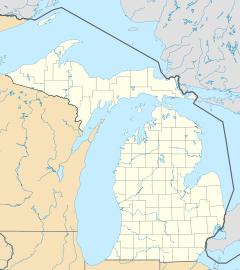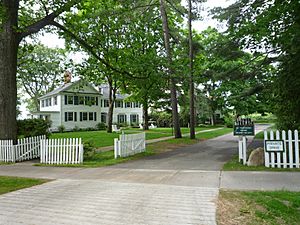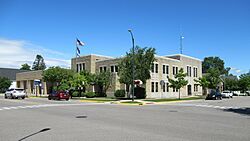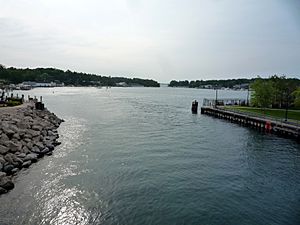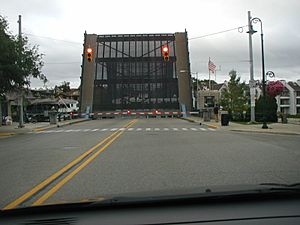Charlevoix, Michigan facts for kids
Quick facts for kids
Charlevoix, Michigan
|
|
|---|---|
| City of Charlevoix | |
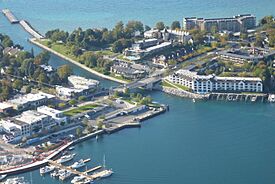
Aerial view of the downtown area with the US 31–Island Lake Outlet Bridge in the center
|
|
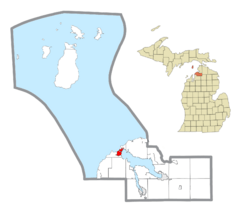
Location within Charlevoix County
|
|
| Country | |
| State | |
| County | Charlevoix |
| Settled | 1852 |
| Incorporated | 1879 (village) 1905 (city) |
| Government | |
| • Type | Mayor–council |
| Area | |
| • Total | 2.05 sq mi (5.30 km2) |
| • Land | 2.05 sq mi (5.30 km2) |
| • Water | 0.00 sq mi (0.00 km2) |
| Elevation | 594 ft (181 m) |
| Population
(2020)
|
|
| • Total | 2,348 |
| • Density | 1,146.48/sq mi (442.74/km2) |
| Time zone | UTC-5 (EST) |
| • Summer (DST) | UTC-4 (EDT) |
| ZIP code(s) |
49720
|
| Area code(s) | 231 |
| FIPS code | 26-14780 |
| GNIS feature ID | 0623115 |
Charlevoix (pronounced SHAR-lə-voy) is a city in the state of Michigan, USA. It is the main town of Charlevoix County.
Charlevoix is located in Northern Michigan. It sits on a narrow strip of land between Lake Michigan and Lake Charlevoix. The short Pine River cuts through the city. Charlevoix is also the main way to get to Beaver Island, the biggest island in Lake Michigan. You can reach the island by plane or ferry. In 2020, about 2,348 people lived in Charlevoix.
Contents
History of Charlevoix
Charlevoix is named after Father Pierre François Xavier de Charlevoix. He was a French explorer who traveled the Great Lakes. Native American tribes like the Odawa and Ojibwe lived in northern Michigan before Europeans arrived.
Early Settlement (1850s-1860s)
European settlers, mostly fishermen, first came to Charlevoix around 1852. In the 1850s, the people of Charlevoix had a conflict with Jesse Strang. He was the leader of a group called the Strangite Mormons on Beaver Island. In 1853, a small fight happened between the groups. Strang was later killed in 1856.
The Homestead Act of 1862 brought many people to Northern Michigan. This law offered cheap land to settlers. In 1864, settlers built a large dock on Lake Michigan. To make it easier for boats, the Pine River channel was dug deeper in 1869. This connected Lake Michigan to Lake Charlevoix. Charlevoix became the county seat in 1869.
Growth and Change (1869-1880s)
In 1869, the local newspaper, the Charlevoix Sentinel, was started. Before 1869, Lake Charlevoix was higher than Lake Michigan. Digging a channel between them in 1869 helped boats travel easily. This was a big step for trade in the area.
In 1873, train service reached Petoskey, a town nearby. People and goods then traveled to Charlevoix by boat or stagecoach. The Army Corps of Engineers made the Pine River channel wider and deeper between 1868 and 1884. By 1876, Charlevoix was a busy port on the Great Lakes. Lumber mills grew, cutting down trees from around Lake Charlevoix.
The Charlevoix Lumber Company shipped out huge amounts of wood. For many years, Charlevoix was a stop for wood-powered steamships. Charlevoix officially became a village in 1879. In 1883, the "Lewis Grand Opera House" was built to bring more culture to the town. Charlevoix became the county seat again in 1894.
Resort Era (1880s-1918)
In 1880, a group from Chicago started the "Chicago Club," a summer resort. Other important places like the Opera House and churches were also built. In 1892, the first train service came directly to Charlevoix. This made it much easier for people to visit.
The train lines helped new businesses and resorts grow:
- The D.M. Ferry Seed Company expanded its operations in 1892.
- In 1899, the Federal Revenue Cutter Service started taking care of buoys.
- A large sugar beet factory, the Charlevoix Sugar Company, was built in 1902-1903. It didn't make money and closed by 1911.
- In 1909, a developer bought land and had architect Frank Lloyd Wright design a building.
- The train also brought many tourists. Charlevoix became known as a top resort spot. It had three summer clubs: the Belvedere Club, Sequanota Club, and the Chicago Club. There were also fancy hotels and two train stations.
- In 1913, the Pine Point neighborhood opened.
Charlevoix was also a popular stop for many large passenger ships on the Great Lakes.
Between the Wars (1919-1945)
Northern Michigan stayed a popular resort area after World War I. Starting in 1918, a self-taught architect named Earl Young began building his unique "mushroom houses." He used local stones for these special homes.
In 1925, the Belvedere Club built a golf course. It was designed by William Watson and became a famous place for tournaments. In 1918, Albert Loeb, from Sears, built an experimental farm called Loeb Farms. It raised award-winning cattle. The farm closed in 1927.
In 1926, Pine Lake was officially renamed Lake Charlevoix. From 1927 to 1948, a summer camp called Camp Charlevoix helped young boys. During a time when alcohol was illegal (Prohibition), Charlevoix was a popular place for visitors from Chicago.
In 1930, the first Charlevoix Venetian Festival began. It was a boat parade with candles. This festival is still held every year and has grown much bigger. In 1939, Boy Scout Troop 11 was formed. It is one of the oldest Boy Scout troops in Northern Michigan. A new drawbridge was planned for the Pine River in 1940 but was finished in 1947.
After WWII (1945-1980)
After World War II, Charlevoix faced some tough times. Many old industries changed, and people started traveling to new places. Train lines stopped, and big hotels closed. However, new businesses like a nuclear power plant and a cement plant opened in the 1960s. These helped the local economy.
Michigan's first nuclear power plant, Big Rock Point, operated in Charlevoix from 1962 to 1997. In 1967, a large cement plant was built in Charlevoix. This plant has been updated over the years and is still a major part of the local industry.
In 1965, the old Loeb Farms became a medieval castle tourist attraction called Castle Farms. For about 25 years, Castle Farms hosted big rock concerts. In 1974, a radio station called WVOY-AM started in Charlevoix. It was one of the first stations in northern Michigan to play modern hit music.
Recent History (1980-Present)
In 1980, another radio station, WKHQ-FM, began in Charlevoix. The 1980s also saw many new apartment buildings called condominiums built. In 1991, a shopping center called "Charlevoix Commons" opened. The Post Office moved there in 1996.
In 1993, a large golf course and housing area called the Charlevoix Country Club was developed. In 1997, Charlevoix had a fireworks accident during the Venetian Festival. In 2004 and 2005, a large store tried to build in Charlevoix. But local businesses and residents worked together to stop it.
For more historical places, see Charlevoix County.
Geography of Charlevoix
Charlevoix covers about 2.05 square miles (5.30 square kilometers) of land.
Climate in Charlevoix
Charlevoix has a climate with big changes in temperature throughout the year. Summers are warm to hot and often humid. Winters are cold, sometimes very cold. This type of weather is called a humid continental climate.
| Climate data for Charlevoix, Michigan (1991–2020 normals, extremes 1891–present) | |||||||||||||
|---|---|---|---|---|---|---|---|---|---|---|---|---|---|
| Month | Jan | Feb | Mar | Apr | May | Jun | Jul | Aug | Sep | Oct | Nov | Dec | Year |
| Record high °F (°C) | 54 (12) |
65 (18) |
83 (28) |
88 (31) |
94 (34) |
96 (36) |
99 (37) |
97 (36) |
95 (35) |
86 (30) |
76 (24) |
63 (17) |
99 (37) |
| Mean daily maximum °F (°C) | 28.7 (−1.8) |
29.2 (−1.6) |
37.1 (2.8) |
48.0 (8.9) |
61.0 (16.1) |
71.0 (21.7) |
76.0 (24.4) |
75.6 (24.2) |
69.8 (21.0) |
56.7 (13.7) |
44.6 (7.0) |
34.5 (1.4) |
52.7 (11.5) |
| Daily mean °F (°C) | 23.1 (−4.9) |
22.6 (−5.2) |
29.4 (−1.4) |
40.3 (4.6) |
52.0 (11.1) |
62.5 (16.9) |
68.7 (20.4) |
68.1 (20.1) |
61.5 (16.4) |
49.7 (9.8) |
39.1 (3.9) |
29.6 (−1.3) |
45.5 (7.5) |
| Mean daily minimum °F (°C) | 17.5 (−8.1) |
15.9 (−8.9) |
21.7 (−5.7) |
32.5 (0.3) |
43.0 (6.1) |
53.9 (12.2) |
61.3 (16.3) |
60.6 (15.9) |
53.3 (11.8) |
42.7 (5.9) |
33.5 (0.8) |
24.6 (−4.1) |
38.4 (3.6) |
| Record low °F (°C) | −22 (−30) |
−33 (−36) |
−16 (−27) |
3 (−16) |
20 (−7) |
32 (0) |
41 (5) |
37 (3) |
32 (0) |
24 (−4) |
8 (−13) |
−8 (−22) |
−33 (−36) |
| Average precipitation inches (mm) | 2.27 (58) |
1.54 (39) |
1.86 (47) |
2.92 (74) |
3.05 (77) |
2.88 (73) |
2.72 (69) |
3.24 (82) |
3.60 (91) |
4.33 (110) |
2.83 (72) |
2.50 (64) |
33.74 (857) |
| Average snowfall inches (cm) | 29.9 (76) |
19.3 (49) |
12.0 (30) |
5.0 (13) |
0.1 (0.25) |
0.0 (0.0) |
0.0 (0.0) |
0.0 (0.0) |
0.0 (0.0) |
0.2 (0.51) |
6.4 (16) |
27.3 (69) |
100.2 (255) |
| Average precipitation days (≥ 0.01 in) | 18.7 | 13.7 | 10.4 | 11.1 | 12.8 | 10.5 | 9.7 | 10.5 | 12.4 | 17.0 | 15.9 | 17.5 | 160.2 |
| Average snowy days (≥ 0.1 in) | 15.7 | 11.4 | 6.3 | 2.3 | 0.2 | 0.0 | 0.0 | 0.0 | 0.0 | 0.4 | 4.9 | 13.0 | 54.2 |
| Source: NOAA | |||||||||||||
People of Charlevoix
| Historical population | |||
|---|---|---|---|
| Census | Pop. | %± | |
| 1880 | 512 | — | |
| 1890 | 1,496 | 192.2% | |
| 1900 | 2,079 | 39.0% | |
| 1910 | 2,420 | 16.4% | |
| 1920 | 2,218 | −8.3% | |
| 1930 | 2,247 | 1.3% | |
| 1940 | 2,299 | 2.3% | |
| 1950 | 2,695 | 17.2% | |
| 1960 | 2,751 | 2.1% | |
| 1970 | 3,519 | 27.9% | |
| 1980 | 3,296 | −6.3% | |
| 1990 | 3,116 | −5.5% | |
| 2000 | 2,994 | −3.9% | |
| 2010 | 2,513 | −16.1% | |
| 2020 | 2,348 | −6.6% | |
| U.S. Decennial Census | |||
Charlevoix Population in 2010
In 2010, Charlevoix had 2,513 people living there. Most residents (94.2%) were White. About 2% were Native American and 1.2% were African American. The average age in the city was 48.1 years old.
Culture in Charlevoix
Singer/songwriter Joe Henry has a song called "Charlevoix" on his 1990 album. He spent much of his childhood in Michigan.
Festivals and Events
- Petunia Planting: This event started in 1982. Every year, before Memorial Day, hundreds of people plant over 60,000 petunias along Main Street. It makes the city look beautiful!
- Venetian Festival: This festival began in 1931 as a simple boat show. Now it's a week-long event. It includes fireworks, concerts, a parade, athletic events, a carnival, and a boat parade.
- Apple Fest: This festival celebrates apples, a major fruit in Northern Michigan. Local farmers sell their apples downtown. The festival also has pony rides, face painting, and a craft show.
Tourism in Charlevoix
Charlevoix calls itself "Charlevoix the Beautiful." This name was also used for a book by local architect Earl Young. He is famous for his unique stone houses.
Transportation in Charlevoix
Water Travel

Charlevoix is located between Lake Michigan and Lake Charlevoix. The Pine River flows through downtown, connecting the two lakes. The Charlevoix South Pier Light Station marks the entrance to Lake Michigan. Round Lake in Charlevoix is known as a great natural harbor. All boats traveling between Lake Michigan and towns like East Jordan or Boyne City must pass through Charlevoix.
U.S. Coast Guard Station
Charlevoix has a U.S. Coast Guard station. It has been serving the waters of Lake Charlevoix and Lake Michigan for over 100 years. The station helps keep people safe on the water.
Major Roads
 US 31: This is a main highway that goes through Charlevoix. It connects to Traverse City to the south and Petoskey to the north.
US 31: This is a main highway that goes through Charlevoix. It connects to Traverse City to the south and Petoskey to the north. M-66: This road ends in Charlevoix and goes south towards East Jordan.
M-66: This road ends in Charlevoix and goes south towards East Jordan. C-56: This road starts near Charlevoix and goes east towards Boyne City.
C-56: This road starts near Charlevoix and goes east towards Boyne City. C-65: This road ends in Charlevoix and goes south towards Ellsworth.
C-65: This road ends in Charlevoix and goes south towards Ellsworth.
Bus Service
The Charlevoix County Transit System offers bus service throughout the county. Indian Trails also provides daily bus service to other cities.
Train History

Regular passenger train service to Charlevoix ended in 1962. Freight train service ended in 1982. The old train tracks were removed in the 1990s. Parts of the old rail lines are now used as a bicycle trail. The old Charlevoix train station is now a museum run by the Charlevoix Historical Society.
Air Travel
- Charlevoix Municipal Airport (CVX) is a public airport. You can find private planes here. It also offers charter flights to Beaver Island and other places.
Media in Charlevoix
Charlevoix is served by several newspapers: the Charlevoix Courier, the Petoskey News Review, the Traverse City Record-Eagle, and the Detroit Free Press. Most TV and radio stations are based in Traverse City. They serve the whole Northern Michigan area, including Charlevoix.
Notable People from Charlevoix
- Robert Boss, professional football player.
- Bob Carey, All-American football and track-and-field athlete.
- Zach Hankins (born 1996), basketball player.
- Ernest Hemingway, famous author, spent his childhood summers here. Many of his stories are set near Lake Charlevoix.
- Albert Loeb, a leader at Sears and Roebuck, built the Castle Farm complex in Charlevoix.
- Jetty Rae, musician.
- John Bennett Ramsey, businessman, lived in Charlevoix.
- Willard J. Smith, former leader of the United States Coast Guard.
- Glendon Swarthout, novelist.
- Edward Carson Waller, a real estate developer from Chicago, spent time in Charlevoix and developed land here. Waller Road is named after him.
- Alson Wood, Wisconsin politician, lived in Charlevoix.
- Earl Young, famous for building unique stone houses.
Images for kids
See also
 In Spanish: Charlevoix (Míchigan) para niños
In Spanish: Charlevoix (Míchigan) para niños


